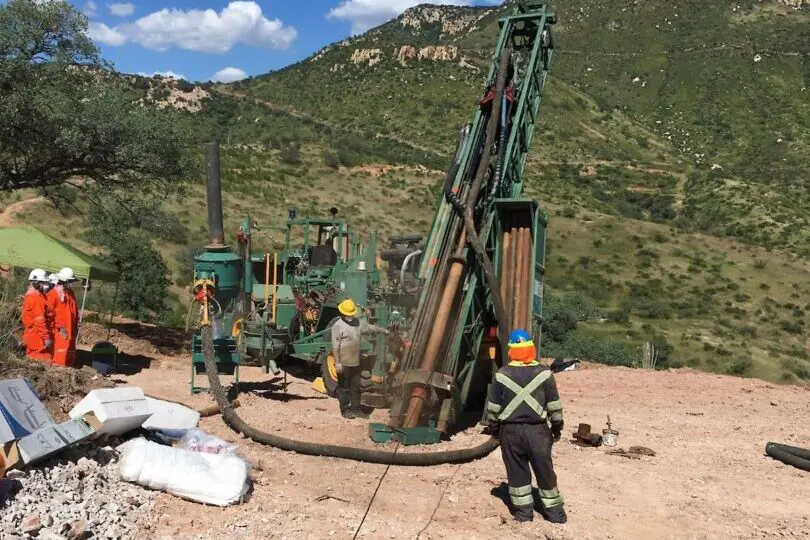VANCOUVER, Canada, November 24, 2020 – Sonoro Gold Corp. (TSXV: SGO | OTCQB: SMOFF | FRA: 23SP) (“Sonoro” or the “Company”) today reported that assay results from an additional 20 reverse-circulation (RC) drill holes at its Cerro Caliche project in Sonora State, Mexico include several of the best gold grade intercepts recorded to date on the property. The Company expects that these results will contribute to establishing a significant addition to Cerro Caliche’s existing 201,000 AuEq inferred resource[1] estimate.
This group of drill holes has successfully enlarged the northwest and southeast extensions of the higher-grade mineralization at the now 450 meter long Buena Suerte zone, which remains open along strike to the northwest and southeast, in addition to extending the strike length of the premier Japoneses mineralized body. The Japoneses increase, which occurred at the northerly Buena Vista and El Boludito extensions and the southerly extension at Cuervos, now demonstrate a continuous strike length of 1.3 km. As in each of the previous 107 drill holes, all 20 of the current group of drill holes encountered reportable mineralization. Assay highlights include the following key intercepts.
At Buena Suerte, SCR-109 successfully tested for a potential northwestern extension along strike and intercepted 45.72 meters averaging 0.97 g/t Au, from 3.05 meters to 48.77 meters, including 15.24 meters averaging 2.1 g/t Au. Hole SCR-124 tested for the Buena Suerte zone’s extension along strike to the southeast and intercepted 6.09 meters averaging 3.99 g/t Au, beginning at 71.63 meters, including 3.04 meters averaging 7.80 g/t Au. SCR-127, which is located near the middle of the zone, intercepted 10.67 meters averaging 0.96 g/t, including 1.52 meters averaging 2.81 g/t Au.
Drilling at the Buena Vista zone confirms that it represents the uninterrupted northwesterly extension component of the Japoneses zone and it remains open along strike to the northwest. Multiple intercepts demonstrate mineralization to over 80 meters depth with deeper potential:
- SCR-110 intercepted 12.19 meters averaging 0.94 g/t Au, including 6.1 meters averaging 1.47 g/t Au.
- SCR-112 intercepted 27.43 meters averaging 0.48 g/t Au.
- SCR 118 intercepted 19.81 meters averaging 0.57 g/t Au, including 1.53 meters averaging 2.34 g/t Au.
At the northernmost extension of the Japoneses zone, Hole SCR-111 at El Boludito intercepted 1.52 meters averaging 2.26 g/t Au and 34.5 g/t Ag. While most intercepts recorded low silver grades, the higher silver grade at SCR-111 reflected the intercept’s higher vertical level in the epithermal vein zoning. The Cuervos zone at the southern extension of Japoneses continues to report strong mineralization, with SCR-122 intercepting 3.05 meters averaging 1.12 g/t Au.
All drill holes are inclined 45 degrees crossing the intervals near perpendicular to the vein’s plane of mineralization. Interval true lengths are near the reported interval length but may be slightly less due to variations in vein zone dips. A cut-off of 0.15 g/t Au was used for reporting intervals and, for consistency, is in the same format as in all previous news reports.
Buena Suerte Zone – Assay Results
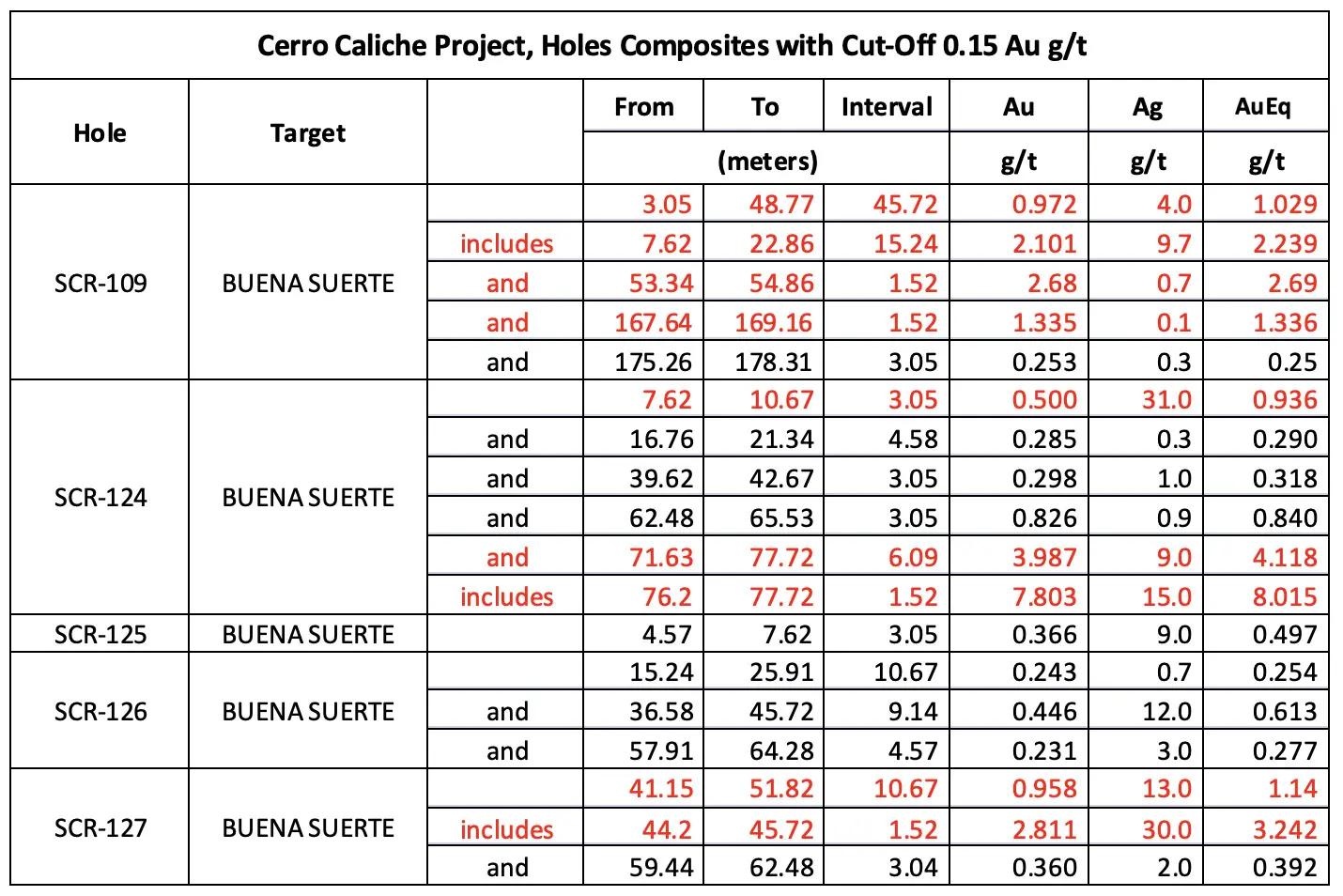
The Buena Suerte zone is independent of other zones, occurring 150-200 meters west of the Japoneses mineralized body. Most of this zone has thin soil cover, especially over the north slope trace of vein extension. The Buena Suerte zone is now confirmed to have more than 450 meters of strike length that is up to 30 meters wide with 80 meters of depth. Host rocks are shattered and veined quartzite with local intrusive rhyolite and minor andesite dikes. Further drilling in this zone has been designed to extend the mineralized zone both to the north and south.
Japoneses Zone – Assay Results (includes Buena Vista, El Boludito and Cuervos)
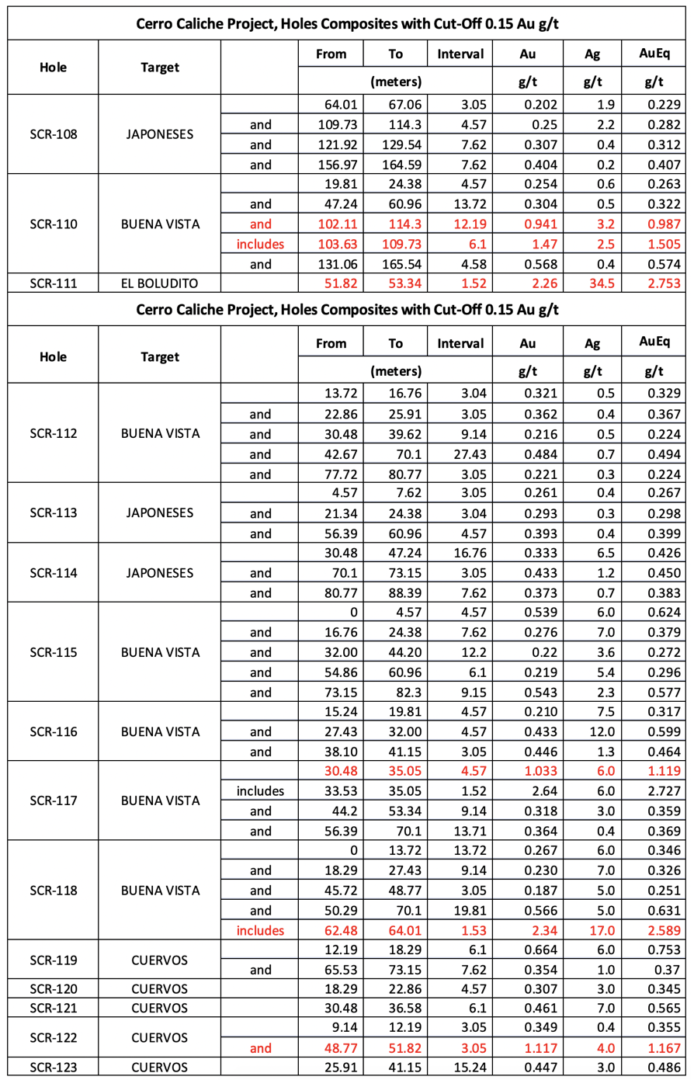
Map of Cerro Caliche RC Drill Holes
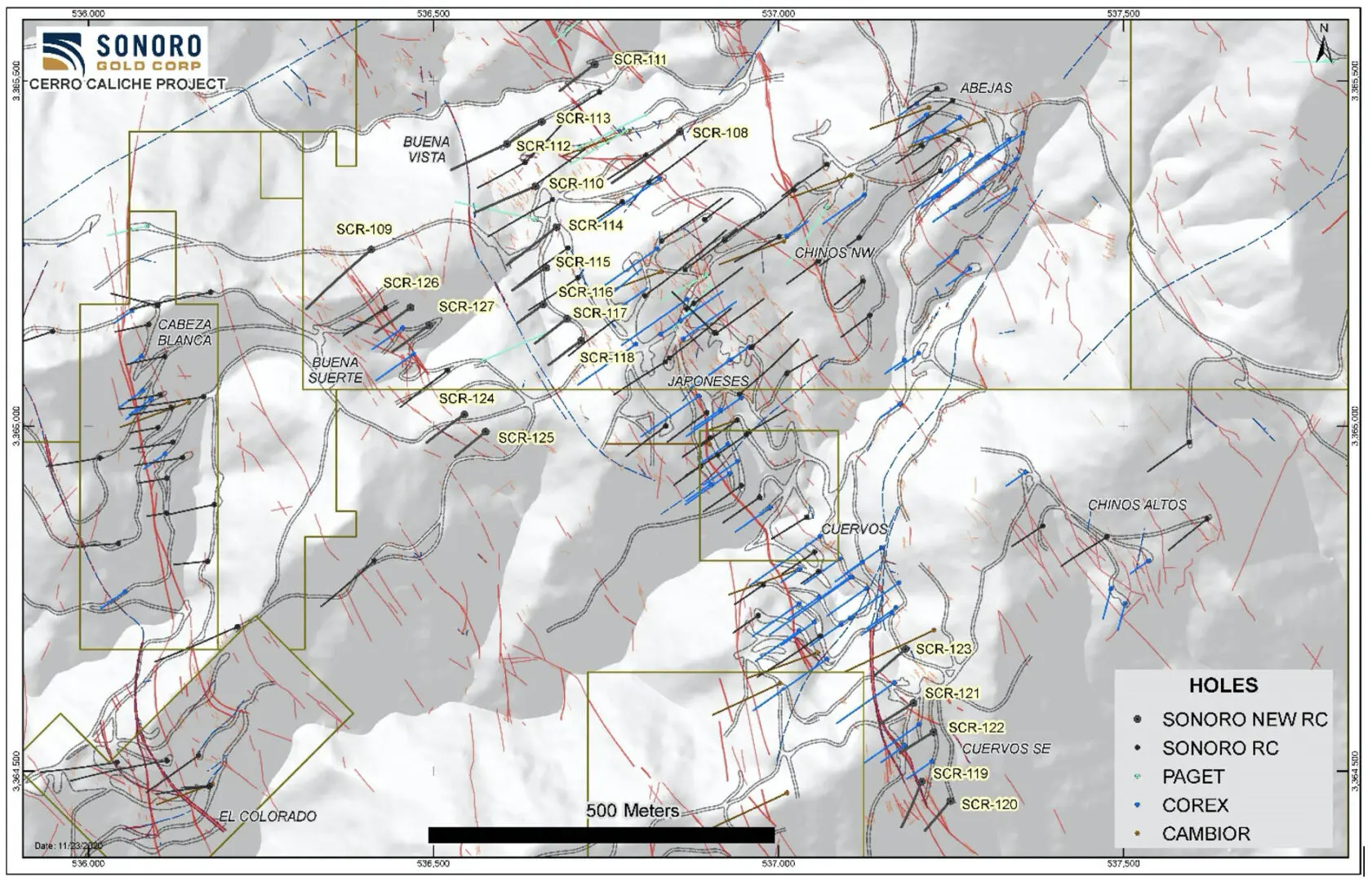
Drill collar locations, azimuths and dips for the drill holes included in this release are provided in the tables below and have been posted to the Company’s website for all drill holes.
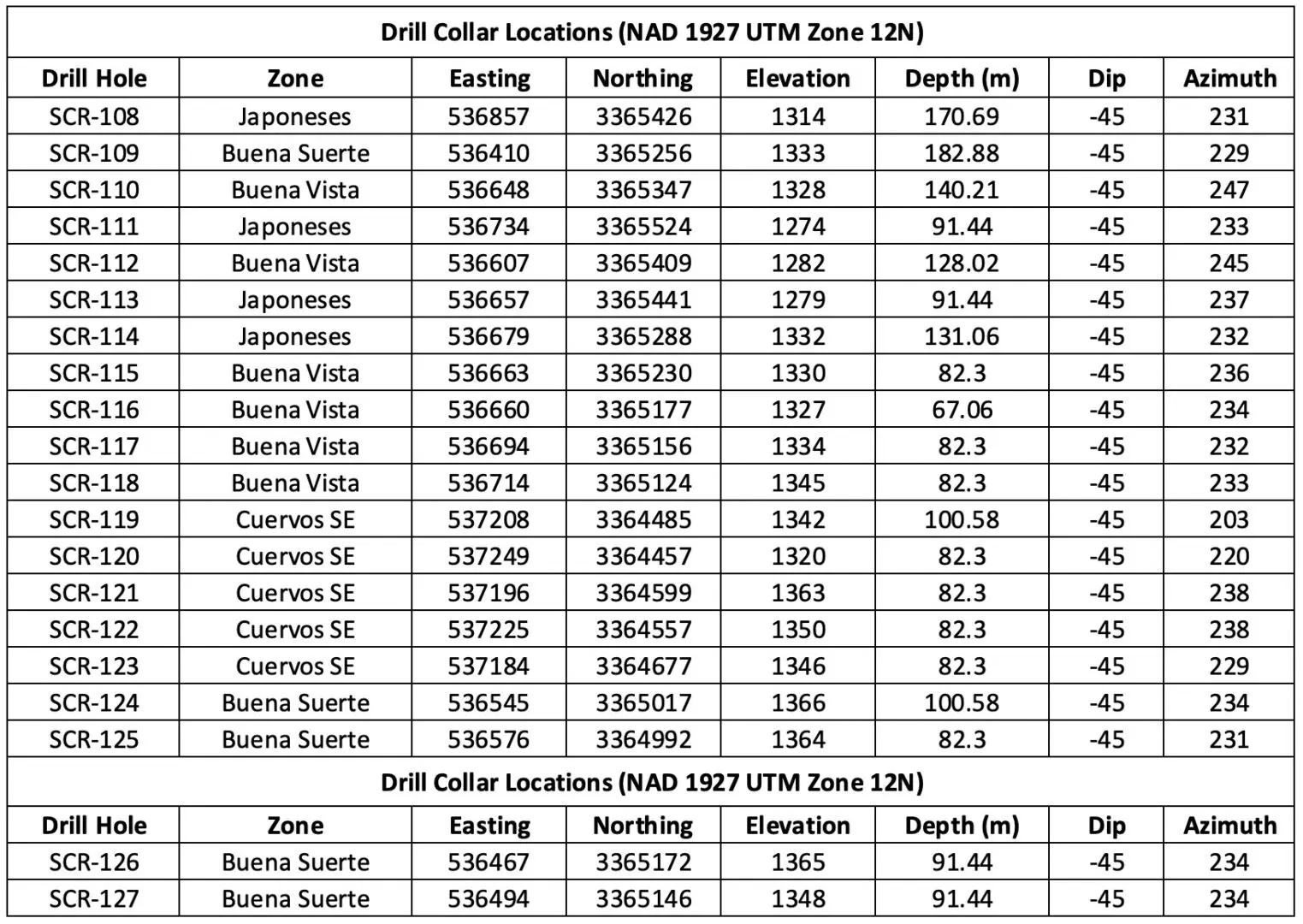
The above drill holes are part of the program to define limits of gold mineralization within the Japoneses mineralized material zone that includes the Japoneses mine zone, the Cuervos mine zone, Boludito zone and Buena Vista zone. The geology in these zones is mainly mineralized structures crossing Mesozoic age quartzite with many fracture zones. This entire mineralized zone is a series of northwest-trending veins, shears and shatter bands in quartzite with shales in its central and southern parts. The northern extension of the Japoneses zone gold mineralization passes into andesite and vein associated rhyolitic dikes where both rock units host gold mineralization.
In total, 44 RC holes have been drilled this year to date, of which 32 have been reported, including the current group of holes. An additional 20 to 25 RC holes are expected to be completed by this coming mid-December and the Company expects that the results of all the drill holes to that date will be incorporated into a new NI 43-101 technical report for publication in the New Year.
Melvin Herdrick, Sonoro’s Vice President, Exploration, stated, “The evident success of the new RC drilling along with the parallel new exploratory core drilling that is oriented toward high grade targeting will be combined into a planned updated resource estimate in early 2021. We anticipate that news in December will also include results from core drilling at El Colorado, where the potential for shoot definition exists, in addition to other more exploratory findings from satellite zones.”
Kenneth MacLeod, Sonoro’s President & CEO, added, “The latest assay results from Buena Suerte provide compelling evidence that it has become one of the prime targets for developing a new, higher grade mineralized zone at Cerro Caliche. We are confident that the current results will contribute to a material increase of the current inferred resource estimate at Cerro Caliche.”
John Darch, Sonoro’s Chairman, further added, “The apparent increase in gold grades and substantial intercept widths adds to our confidence regarding both the viability of our planned 8,000 ton per day mining operation which is targeted to commence production next December 2021 and our longer term goal of materially increasing the size of the mineralized body and proposed mine by continuing to successfully explore and develop the property.”
The current exploration work is part of the Company’s conceptual fast-track development schedule for the Cerro Caliche project with the aspirational goal of commencing gold production by the end of 2021. Key milestones, whose achievement is essential for the successful realization of this goal, include the satisfactory completion of metallurgical testing, securing the required environmental permitting, receiving a favorable preliminary economic assessment (PEA) and obtaining the necessary project financing. On November 18, 2020, the Company announced that it had retained McClelland Laboratories Inc. of Sparks, Nevada to conduct independent metallurgical testing. These tests are a fundamental component of the PEA which in turn is expected to be completed by April 2021. Earlier this year, after a period of extensive analysis of the Cerro Caliche project data, a major China-based Engineering, Procurement and Construction (EPC) company executed a Memorandum of Understanding with Sonoro making it the third EPC company to formally pursue discussions with the Company regarding the proposed mine’s financing and development.
Quality Assurance/Quality Control (“QA/QC”) Measures and Analytical Procedures
Drill samples are collected with an airstream cyclone and passed into a splitter that divides each sample into quarters. The quartered samples are then bagged and sealed with identification. The sample group has blanks, standards and duplicates inserted into the sample stream.
ALS-Chemex collects the samples and transports them directly to the preparation laboratory in Hermosillo, Sonora. At the laboratory, part of each sample is reduced through crushing, splitting and pulverization from which 200 grams is sent to the ALS-Chemex assay laboratory in Vancouver. Thirty grams undergoes fire assay for gold with the resulting concentrated button of material produced dissolved in acids and the gold content determined by atomic absorption. Another quantity of the sample is dissolved in four acids for an ICP multi-element analysis.
To improve upon assay turnaround times, the Company has contracted with the Hermosillo office of Bureau Veritas Laboratories to also provide assays in a timely fashion. Accordingly, the samples are now being collected by Bureau Veritas for direct transport to the preparation and assaying laboratory in Hermosillo, Sonora. At the laboratory, part of each sample is reduced through crushing, splitting and pulverization. About 200 grams is sent by BV to their Vancouver, BC laboratory and dissolved in aqua regia for multi-element ICP analysis including silver. Thirty grams undergoes fire assay in Hermosillo for gold by reducing the fire assay to a concentrated button of material that is dissolved in acids and the gold content determined by atomic absorption. No QA/QC issues were noted with the results received from either laboratory.
Geologic Description
Cerro Caliche is located 45 kilometers east southeast of Magdalena de Kino in the Cucurpe-Sonora Mega-district of Sonora, Mexico. Multiple historic underground mines were developed in the concession including Cabeza Blanca, Los Cuervos, Japoneses, Las Abejas, Boluditos, El Colorado, Veta de Oro and Espanola. Mineralization types of the Cucurpe-Sonora Mega-district include variants of epithermal low sulfidation veins and related mineralized dikes and associated volcanic domes. Local altered felsic dikes cut the mineralized meta-sedimentary rock units and may be associated with mineralization both in the dikes and meta-sedimentary rocks.
Host rocks include Jurassic-Cretaceous meta-sedimentary rock units including argillite, shale, quartzite, limestone, quartz pebble conglomerate and andesite. Younger intrusive rock consisting of medium coarse-grained granodiorite-granite is present in the westerly parts of the concessions near the historic Cabeza Blanca Mine. It is apparent that veining cuts and pervasively alters the intrusive stock. Rhyolite occurs in irregular bodies distributed in higher elevations in the northerly part of the concession, including the Rincon area, where it occurs as flows, sills, dikes and rhyolite domes. Part of the rhyolite is mineralized and appears to be related to epithermal gold mineralization throughout the property.
Qualified Person Statement
Stephen Kenwood, P.Geo., a director of Sonoro, is a Qualified Person within the context of National Instrument 43-101 (NI 43-101) and has read and approved this news release. Readers are cautioned that the presence of mineralization on historic mines adjacent to or on Cerro Caliche is not necessarily indicative of gold mineralization in the concessions held by the Company.
About Bureau Veritas Laboratories
Bureau Veritas Laboratories is a North American provider of analytical services and solutions to the environmental, energy, food, DNA and industrial hygiene industries with an extensive laboratory network in Canada. Bureau Veritas’ work supports critical decisions that improve performance, reduce risk or help customers meet safety, quality and regulatory objectives. Founded in 1828, Bureau Veritas is the global leader in testing, inspection and certification services with 78,000 employees in 1,500 locations worldwide.
About Sonoro Gold Corp.
Sonoro Gold Corp. is a publicly listed exploration and development company with a portfolio of exploration-stage precious metal properties in Sonora State, Mexico. The Company has highly experienced operational and management teams with proven track records for the discovery and development of natural resource deposits.
On behalf of the Board of SONORO METALS CORP.
Per: “Kenneth MacLeod”
Kenneth MacLeod
President & CEO
For further information, please contact:
Sonoro Metals Corp. – Tel: (604) 632-1764
Email: [email protected]
Forward-Looking Statement Cautions: This press release contains certain “forward-looking statements” within the meaning of Canadian securities legislation, relating to, among other things, the Company’s plans for the drilling of the above-described Cerro Caliche Concessions, located in the municipality of Cucurpe, Sonora, Mexico, and the Company’s future exploration and development plans for those properties. Although the Company believes that such statements are reasonable based on current circumstances, it can give no assurance that such expectations will prove to be correct. Forward-looking statements are statements that are not historical facts; they are generally, but not always, identified by the words “expects,” “plans,” “anticipates,” “believes,” “intends,” “estimates,” “projects,” “aims,” “potential,” “goal,” “objective,” “prospective,” and similar expressions, or that events or conditions “will,” “would,” “may,” “can,” “could” or “should” occur, or are those statements, which, by their nature, refer to future events. The Company cautions that forward-looking statements are based on the beliefs, estimates and opinions of the Company’s management on the date the statements are made and they involve a number of risks and uncertainties, including the possibility of unfavourable interim exploration results, the lack of sufficient future financing to carry out exploration plans, and unanticipated changes in the legal, regulatory and permitting requirements for the Company’s exploration programs. There can be no assurance that such statements will prove to be accurate, as actual results and future events could differ materially from those anticipated in such statements. Accordingly, readers should not place undue reliance on forward-looking statements. The Company disclaims any intention or obligation to update or revise any forward-looking statements, whether as a result of new information, future events or otherwise, except as required by law or the policies of the TSX Venture Exchange. Readers are encouraged to review the Company’s complete public disclosure record on SEDAR at www.sedar.com.
Neither the TSX Venture Exchange nor its Regulation Services Provider (as that term is defined in the policies of the TSX Venture Exchange) accept responsibility for the adequacy or accuracy of this release.
[1] NI 43-101 Technical Report on the Cerro Caliche Property, July 26, 2019, Strickland, D., Sim, R.C. prepared for Sonoro Metals; comprised of an inferred resource of 201,000 AuEq ounces at a grade of 0.55 AuEq (0.495 g/t Au and 4.3 g/t Ag).
Original Article: https://sonorogold.com/news/sonoro-drills-45-72-meters-of-0-972-grams-per-tonne-in-new-zone-at-cerro-caliche/
